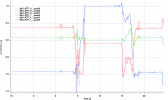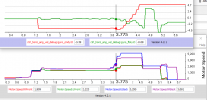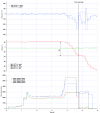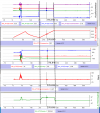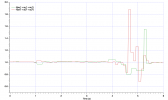The "Automated takeoff.DAT" wasn't an actual flight but it provided the most interesting data. Like the other two .DATs it showed an initial pitch up of about 20°. But, at 221 secs the accelerometer data then became strange and almost certainly non-physical. In brief it looks like the FC decided to calibrate the IMU(s) by first turning off the IMU heater to cool down to 31.2° C. This was then followed by turning on the heater. When the IMU reached the operating temp of 65° C the accelerometers were then set to values consistent with the M2E resting level on a flat surface. In particular the pitch was then 0°
This also happened in the "Manual Takeoff .DAT" but long after the launch attempts were made and the M2E was at rest on the ground.
It appears to me that the FC performed an IMU calibration because it decided the IMU was not calibrated properly. If not then it's probably a HW malfunction and needs to be repaired.
@BobbyXo can you try an IMU calibration? And, then power off/on the M2Eand let sit at rest for 300 secs. Then post both .DATs
Here the plots from the "Automated Takeoff .DAT".
View attachment 129702
The top 2 plots show the composite acceleration not equal to 1.0 during the IMU warm up interval. This is clearly not physical if the M2E is at rest which is shown by the mag and gyro data in plots 3 and 4. Finally, the bottom plot shows a correct pitch of 0° after the IMU warm up.
The above shows the IMU(0) data but the same is true for the IMU(1) data. This would argue for a faulty IMU calibration. That, or even though the M2 has "dual IMUs", there is only one set of accel and gyro sensors. The dual IMU records come from either dual circuitry excluding the sensors or two different fusing algorithms using the same IMU data.
